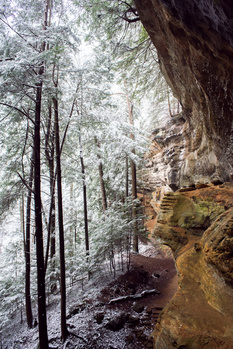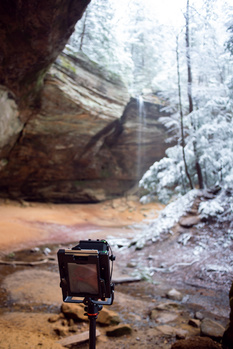For some, the “magic” of film, medium format especially, or the benefit of full frame digital is all hype. Is it really just hype or can you tell a difference?
In this article, I am going to share the results of a series of photographs that were each taken with an iPhone, a full frame digital camera, and a medium format film camera. All photographs were taken on the same snowy day in Hocking Hills State Park in Ohio. Each photo was edited as I would normally would and is presented with a letter in the bottom right corner of the frame to be able to consistently judge across the different images which camera took which photograph. Each photo was cropped to be a 1:1 format so as to not completely give away the answer based solely on the aspect ratio of the image. In addition, while I don’t have lenses for each that are in perfect equivalence, I used the widest good lens I had for the digital camera and film camera to at least try and not have the focal length give away the results either.

For consistency between the digital camera and film camera, the shutter speed was metered using the digital camera using the same aperture, shutter speed, and ISO. Lastly, it should be noted that I did not attempt to edit each photo to look identical to one another. Instead, I edited the shots as I normally would given the camera/film stock.
- iPhone X and images edited in LR Mobile
- Sony a7R II equipped with a Nikon 28mm f/2.8 Ai-S shot at ISO 400
- Mamiya RZ67 paired with a 65mm f/4.0 W using Portra 400, shot and processed at 400 ASA, scanned using Epson V600 and inverted/edited with Negative Lab Pro
For our first comparison, we are looking at Ash Cave, which provides an excellent opportunity to really exercise the dynamic range of each camera. In addition, the cave itself is quite enormous and looks beautiful after a fresh coat of snow. Camera A really struggled with this photo as the shadows got quite muddy and just about all of the details south of the bottom of the trees are also quite muddy. Between Cameras B and C, the color palette is different but overall, they both seemed to perform well. If I were to be really picky, I may say that the edge goes to Camera B where the shadows seem to have kept more detail.
The second comparison is of a broken tree in the woods. I don’t know what attracted me to this scene, but I really liked it. For this comparison, Cameras A and C were much closer than in many of the others — the color palettes are very similar. Camera B was also close but a tad warmer.
The third comparison, of Lower Falls, had similar results as the previous set of photos with one exception. Camera A produced a slightly warmer shot than Camera C, and once again, Camera B was warmer than both of the other two. Overall, I think all three cameras performed quite well, and trying to say one is better than another would come down to splitting hairs.
At the risk of sounding like a broken record, the results of the fourth comparison are much like that of the previous ones. Camera A just isn’t as sharp as the other two, and the color palette of Cameras A and C produced similar images, while Camera B is a good deal warmer.
The last comparison is of a barn just outside of Hocking Hills. This comparison was much closer than just about all of the others, I think. The main difference was in sharpness, where Camera A is not quite as sharp as the other two. The second difference was in the tendency for Camera A to be cool and Camera B to lean a bit warm.
Final ResultSo, do you think you know which camera is which? If you’re at all familiar with Portra 400, you have probably guessed that Camera B is the Mamiya RZ67 loaded up with Portra 400. For film enthusiasts, the tones of the Portra series are pretty hard to mistake. In addition, if you’ve been looking at the images closely, you’ve probably noticed that while Camera A had sufficient clarity for a small print, the resolution is nowhere close to that of Camera C, which means, you guessed it, Camera C is the Sony and Camera A is my iPhone.

There are, of course, limitations to any comparison like this — most notably would be with the representation in the film category. That is, the choice of format (e.g., 645, 6x6, 6x7, etc…) would have a pronounced impact on the perceived sharpness of an image. In addition, the choice of the film itself can have a large impact on the final results. As you may recall from a previous article outlining the different types of film, slide film would offer substantially more clarity and more vibrancy but suffers from a much-reduced dynamic range. In addition, even a move from Portra 400 to Ektar, another color negative film, would have resulted in better sharpness and more saturated colors.
In addition to the choice of film stock and film format as ways to get substantially different results, the specific digital camera and lens used could also substantially alter the results of a comparison. That said, I only own one digital camera, and my Nikon 28mm is an exceptionally sharp lens and the widest good lens that I own.

Beyond the limitations presented by the choice of cameras and film stock, I would like to also acknowledge that all of my comparisons are made on landscapes only in a snowy Hocking Hills. For a portrait photographer, the comparisons I’ve made would be of limited to no utility. Even for a landscape photographer, drastically different scenes could present their own challenges would potentially better highlight the differences (or lack thereof) between the different cameras.
To start, I’ll admit that had I really put forth effort to try to mimic film with my digital shots; I think the comparison would have been much harder between the Mamiya and the Sony. That said, I have a pretty consistent editing style at this point in my life if for no other reason than that I strongly prefer for the film stock to do the talking when it comes to the color palette and sharpness. As a result, editing my digital images have similar results in that they have minimal edits to them, letting the color tendencies of the specific camera/lens shine through. At the end of the day, the best camera is the one you have on you. Should you have more than one camera one you at the time, particularly if you’re counting your phone? How do you decide which to use?



















